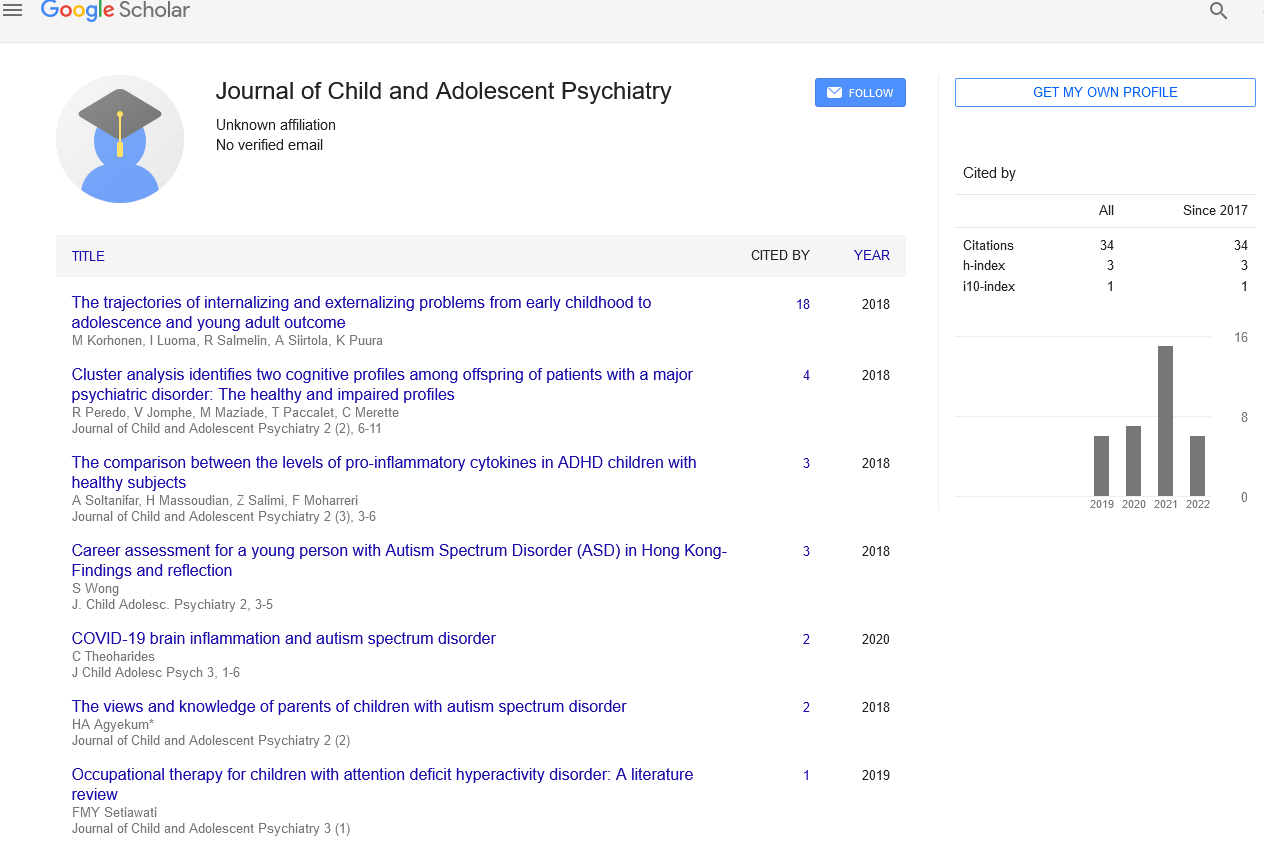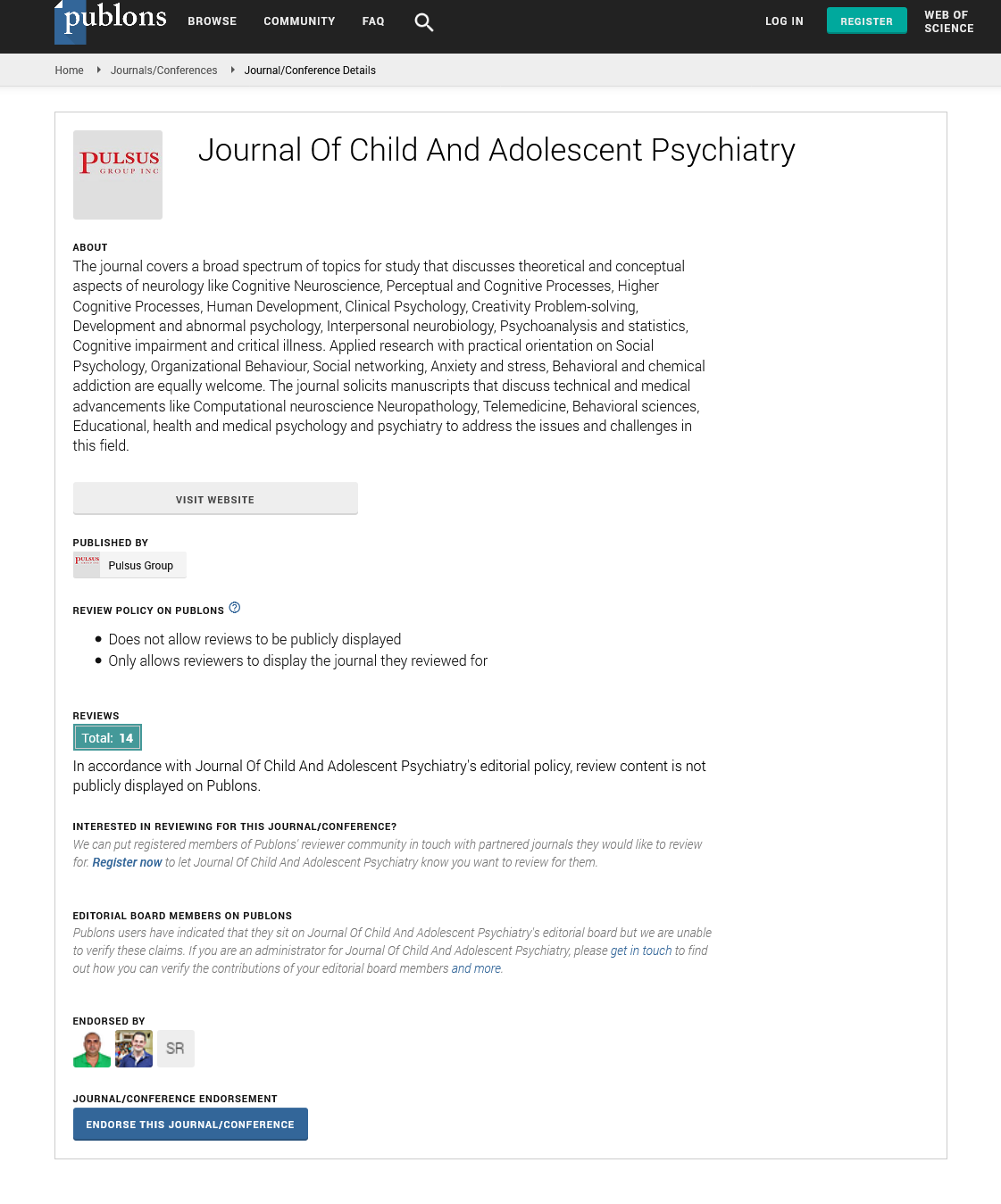School children's anxiety as a common biomarker
Received: 04-May-2022, Manuscript No. PULJCAP-22-5002; Editor assigned: 12-May-2022, Pre QC No. PULJCAP-22-5002(PQ); Accepted Date: May 18, 2022; Reviewed: 14-May-2022 QC No. PULJCAP-22-5002(Q); Revised: 16-May-2022, Manuscript No. PULJCAP-22-5002(R); Published: 24-May-2022, DOI: 10.37532/ puljcap.2022.6(3);24-25
This open-access article is distributed under the terms of the Creative Commons Attribution Non-Commercial License (CC BY-NC) (http://creativecommons.org/licenses/by-nc/4.0/), which permits reuse, distribution and reproduction of the article, provided that the original work is properly cited and the reuse is restricted to noncommercial purposes. For commercial reuse, contact reprints@pulsus.com
Abstract
Currently little or no proof is to be had concerning the organic traits and not unusual place comorbid behaviors which are related to kids characterized through studying problems who require extra assist at school. These kids are commonly called having Additional Health and Developmental Needs through the Australian Government and the related public training gadget greater extensively even though the troubles might also additionally stand up from academic, social and/or emotional stressors and can or won't encompass kids with clinically identified Neurodevelopmental Disorders. Thus, the intention of this examine become to research the connection among tension stages (Spence Children`s Anxiety Scale- Parent Report), autism tendencies (Autism Spectrum Quotient – Child Version) and sleep highsatisfactory (Sleep Disturbance Scale for Children) in kids with Additional Health and Developmental Needs without an highbrow dis- -ability, however with both a prognosis of Autism Spectrum Disorder (ASD) , Speech and Language Impairment or Other Diagnosis. Our consequences tested that those kids with Additional Health and Developmental Needs confirmed atypically excessive stages of tension and impaired sleep high-satisfactory, with the ASD organization reporting greater impairments related to comorbid tension and sleep high-satisfactory than both of the alternative clinically identified groups. In fact, extra tension stage become related to a extra quantity of autism tendencies and poorer sleep high-satisfactory irrespective of diagnostic organization suggesting that tension is a not unusual place enjoy for kids with Additional Health and Developmental Needs. It is recommended that evaluation of tension, sleep behaviors and autism tendencies can be beneficial markers for early identity of kids inside this population, as a result offering scope for early and targeted intervention.
Keywords
Generalized Tension Disorder; Oppositional Defiant Disorder
Introduction
Oppositional defiant sickness (ODD) and generalized tension sickness (GAD) are a number of the maximum not Childhood is the maximum vital developmental period, making the identity of instructional and intellectual fitness problems and the want for developmentally suitable early intervention fundamental. It is predicted that as a minimum 1 in five youngsters in Australia require more guide at faculty because of a extensive variety of recognized and undiagnosed developmental problems, studying, behavioral and/or emotional problems. These youngsters are categorized via way of means of the Australian Government and public training gadget as having Additional Health and Developmental Needs (AHDN), now and again called Special Health Care Needs.
Thus AHDN youngsters have grown to be categorized as “folks that have, or are at accelerated danger for a continual physical, developmental, behavioral, or emotional situation and who additionally require fitness and associated offerings of a kind or quantity past that required via way of means of youngsters generally. Such desires can be established (recognized at faculty entry) or emerging (diagnosed via way of means of teachers), suggesting that problems mentioned at faculty can be indicative of an underlying organic problem. The developmental traits of youngsters with AHDN are in large part unknown, for the reason that they may be frequently excluded from research, authority’s guidelines and get entry to to investment for interventions. We set out to analyze whether or not any such organization of youngsters with AHDN percentage not unusual place organic traits and behavioral comorbidities regardless of the etiology or environmental supply in their number one difficulty. Anecdotally it's far frequently assumed that studying problems are a supply of tension, a declare this is supported via way of means of proof that decrease highbrow cap potential is associated with accelerated tension, sleep problems and unsuccessful social interactions. Lower formative years IQ is likewise recognized to be related to an accelerated danger of growing Generalized Anxiety Disorder (GAD), obsessive–compulsive signs and symptoms, despair and schizophrenia in adulthood. Conversely, better formative years IQ may be a defensive aspect for tension, with overall performance one popular deviation above the imply on a Full Scale IQ evaluation on the age of 7 notion to lessen the lifetime danger of a GAD prognosis via way of means of 50%.
Thus, this take a look at targeted on investigating tension in youngsters with a variety of diagnoses who have been diagnosed as suffering at faculty. Anxiety is a prevalent human experience, underpinning fundamental adaptive behaviors which include the `fight, flight or freeze` response. By comparison, recognized or scientific formative years tension is a main burden of disease and is related to terrible vanity and reduced nice of life, with even sub threshold signs and symptoms being predictive of scientific tension, despair and temper problems in each youth and adulthood. Given that tension is thought to have an effect on an individual`s whole organic gadget, we in addition recommend that positive behaviors can be symptomatic of tension (center biomarkers, which include insomnia and worry (extended rumination approximately destiny events). These behaviors may also are expecting behavioral expressions of tension (which include sleep and autism trends) inyounger youngsters who do now no longer always meet complete diagnostic category of an Anxiety Disorder however nevertheless have deficits in regular functioning. Identification of center biomarkers is specifically crucial for youngsters who might not be capable of verbally explicit their tension or perceive feelings because of problems with speech and language which include people with autism spectrum disorder (ASD). Early intervention has been pronounced to lessen tension in youngsters, however, long term consequences stay in large part unknown in youth and adulthood, highlighting the want for higher detection in advance in formative years. Anxiety stocks many center capabilities and is typically comorbid with ASD, wherein tension has been counseled as an underlying purpose of ASD signs and symptoms. An in any other case neuro typical baby who affords with tension frequently reveals a spectrum of behaviors steady with ASD trends which include tension of notion, rigid conduct, sleep problems and emotional dys regulation.Such observations have caused the conceptualization of the spectrum of autism as consisting of non-scientific people with in- -side the wider populace who own associated trends to various degrees, and whose conduct is identified as related to tension, despair, worse instructional overall performance and sleep disturbances. Anxiety and sleep have a bidirectional courting. Sleep troubles in formative years are related to accelerated signs and symptoms of Generalized Anxiety Disorder, somatic complaints, aggression, poorer empathy and reduced attention and are identified as having bad effects for studying and attention, decreased awareness and immune gadget functioning. Difficulty with sleep may be a behavioral result of tension this is additionally related to ASD signs and symptoms.
Poor sleep is thought to make contributions to difficult behaviors throughout the autism spectrum leaving us questioning if sleep disturbances can also additionally be an crucial function of youngsters with AHDN.Thus as preceding literature has documented a courting among tension and sleep nice, and tension and ASD we set out to analyze the relationships among all 3 variables of anxiety, autism behaviors and sleep quality






